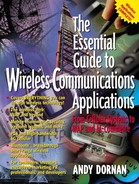Chapter 2. Radio Spectrum
In this chapter…
Radio is at the heart of wireless communications. Its basic principles are more than a century old, but it continues to evolve almost as fast as computing. Digital broadcasting has managed to cram more capacity out of old wavebands, while new technology opens up new ones. The persistent electronics revolution is making radio circuitry smaller and lighter, to the point where transceivers that fit onto a single microchip transmitter are no longer a fantasy.
Despite the advances, radio spectrum remains a finite resource. While anyone can lay fiber cables in the ground, not just anyone can start their own cellphone network. Licensing remains a controversial issue, with governments, corporations, and other interests unable to agree on how the spectrum should be divided up.
There are some wireless technologies that don't rely on radio. Infrared is used by common household devices, such as remote controls, as well as for linking computers to each other or to peripherals. Point-to-point links can use all kinds of other signals, including laser beams. But as yet, these are mainly niches. For the immediate future, most wireless applications will remain dependent on radio.
